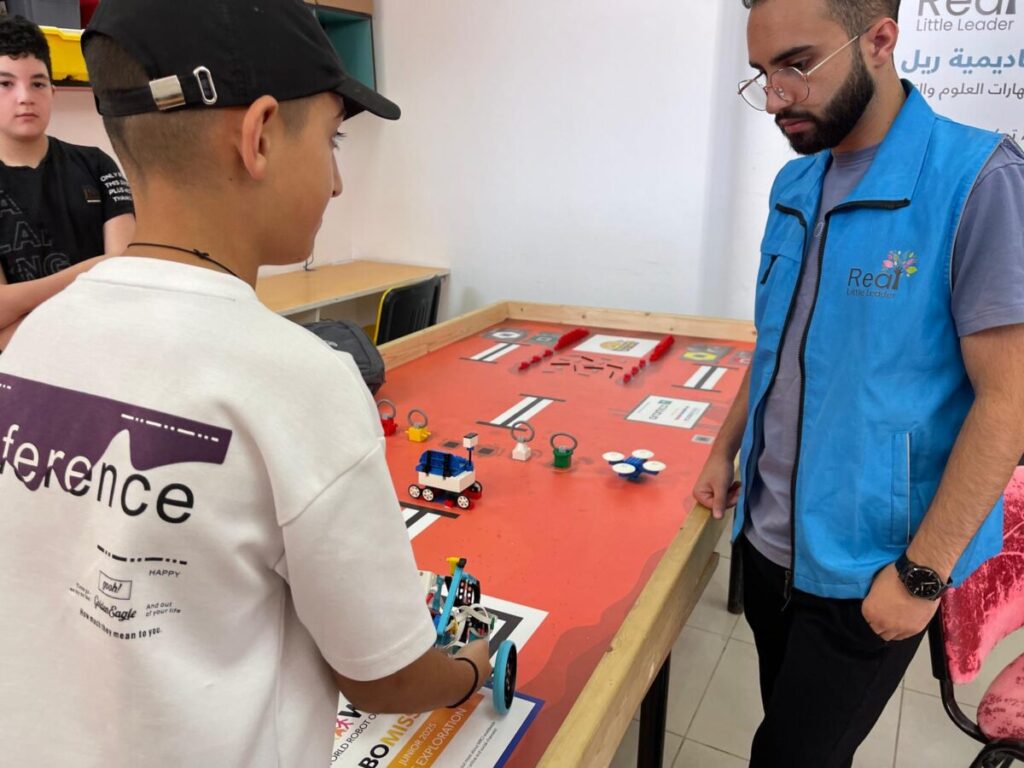Like all children in the world, they dream of joining the global technological revolution. In the Dheisheh refugee camp, southwest of Bethlehem, a group of young innovators is helping to make this dream possible. They have created the Rails Academy for artificial intelligence and modern technology, allowing young Palestinians to pursue ambitions that the UNRWA classrooms cannot offer.
In the schools of the Palestinian refugee camps run by UNRWA (United Nations Relief and Works Agency for Palestine Refugees), students receive only basic education — sciences, mathematics, history, and other standard subjects. Technological advancements or the rise of artificial intelligence are absent from the curricula. Founded by a group of young innovators, an academy unlike any other offers them an unlikely opportunity here: to experiment, create, and participate in the world of robotics, coding, and AI. The Rails Academy has also opened the door to participation in international competitions.
Coding behind the walls
Mustafa Mohammed, 12 years old, is “happy and excited” to be part of the Rails Academy, where he and his peers discover robots, solar panels, and even Mars rovers, those mobile vehicles designed to explore areas inaccessible to humans. “We simulate a Mars expedition on the classroom table. The children manage the Martian water supply using small vending robots and send samples with drones to the laboratories,” he explains.
This year, Mustafa has learned to code with Spike Prime and dreams of representing Palestine at the World Robotics Olympiad in Singapore. “I want to be a global programmer and start my own business,” he confides. The academy has given me the chance to start realizing my dream.” He enthusiastically describes his new programming skills with Word blocks and Icon blocks, as well as building and coding different components of a robot, like a robotic arm. He also explains that he now knows how to use a color sensor and distinguish between two functions: one for detecting black lines and another for recognizing multiple colors.
Endlessly, he adds that he has also learned to build a sturdy robotic structure and overcome obstacles. He emphasizes that he is particularly happy this year to develop problem-solving skills without relying on others.
When fathers become builders of the future
Iyad Abu Alia, one of the academy's administrators, explains that the project started as a small program targeting children aged 5 to 19. “Our children in the camp are naturally drawn to technology. But opportunities were either unavailable or too expensive for families here,” he confides.
Working with local community groups, volunteers built the foundations of the academy. Today, about a hundred children are enrolled in three laboratories, but as many are still on the waiting list, as resources are insufficient to accommodate them.
“We are fathers and community activists. We have seen our children using phones and computers, drawn to technology, but without access to real training. Outside programs were too expensive for families in the camp. So, we created this academy with the support of the popular committee and local institutions,” Abu Alia specifies. The structure also offers summer programs combining play and technical skills.
A connected youth despite the obstacles
The academy aligns with the 17 UN Sustainable Development Goals, particularly by promoting environmentally friendly technology. Eight teams are currently preparing for national qualifications at Birzeit University before the World Robotics Olympiad in Singapore in October. Others are set to travel to Slovenia in September.
Abu Alia recounts that the academy recently graduated its first group from a “Robot Starter Sumo” course, allowing children to design and program collision vehicles. “For the first time, children feel that they are not just buying a toy — they are creating it,” he insists.
The lack of resources, a permanent hindrance
However, the academy faces serious challenges, particularly a lack of equipment. “One laptop must serve 18 children working in teams,” notes Abu Alia. We accomplish a lot with very limited tools, but the lack of funding and the absence of official sponsors remain our biggest obstacles.”
Nevertheless, the vision remains ambitious: to transform children from mere consumers of technology into true producers and innovators. The goal of the Rails Academy is clear: to become a recognized educational institution in 21st-century skills and to ensure that every child has a place in the digital world.
Already, the youth of the camp are beginning to think differently, even imagining how to prepare Mars for life. “This is how they start to think outside the box,” emphasizes Iyad Abu Alia.
For him, what has been accomplished is just a step. “We want every Palestinian child to feel that they have a role to play in building the future,” he insists.
The Rails Academy does not just train in robotics or coding: it embodies a promise of empowerment through technology, a bet on youth and their ability to invent a future that transcends the walls of the camp.

Featured photo: the Rails Academy welcomes both girls and boys aged 5 to 19©Ahmad Jibran
